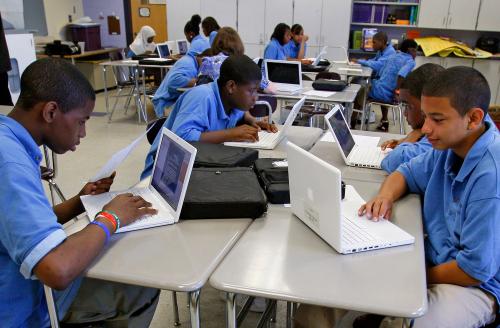If you want more content like this, subscribe to our newsletter.
This week in Class Notes:
-
- Renters with African American or Hispanic/LatinX names are 41% less likely than those with White names to receive responses for properties in areas with low pollution exposure.
- The same genetic markers that predict educational attainment have been found to predict household wealth.
- The expansion of the Total and Permanent Disability Discharge program to include permanently disabled Social Security Disability Insurance (SSDI) and Supplemental Security Income (SSI) recipients raised the probability of applying for SSDI or SSI in a given quarter among student loan-holders by 50%.
- Our top chart shows that approximately 50% of total household income generated in 2012 flowed to households in the top 20% income bracket, compared to 5% for those in the bottom 20% income bracket.
- Michael Strain argues that it is possible to finance a middle-class life on one income.
- Finally, check out Tiffany Ford and Richard Reeves’ new piece “College for people like me: How majority-Black campuses boost social mobility” on the role of majority-black colleges in promoting economic mobility.
Housing discrimination and pollution exposures in the United States
Local pollution exposure disproportionately affects minority households, yet it is unclear whether this is the result of racial discrimination. In this paper, Christensen et al. present experimental evidence that racial discrimination constrains the housing choices of minority households with respect to major polluting facilities in the United States. Renters with African American or Hispanic/LatinX names are 41% less likely than renters with White names to receive responses for properties in low exposure locations. The authors find no evidence of discriminatory constraints in high exposure locations, indicating that discrimination increases minorities’ relative access to housing at high levels of exposure.
Genetic endowments and wealth inequality
Wealth inequality in the United States and many other countries is large and growing, with potential explanations ranging from variation in the earnings process to differences in entrepreneurial talent and levels of risk aversion. In this study, Barth et al. examine a biological basis for heterogeneity in wealth: differences in genetic endowments related to educational attainment. The authors show that the same observed genetic markers that predict education also predict household wealth. Additionally, the authors provide preliminary evidence that genetic endowments are associated with wealth not only through educational attainment and income, but through various dimensions of financial decisionmaking, including stock market participation, business ownership, financial planning horizon, and macroeconomic expectations.
Does student loan forgiveness drive disability application?
Student loan indebtedness is a substantial weight on many individuals’ and households’ finances, just as coping with chronic and long-term health conditions that interfere with employment can be. The July 2013 expansion of the Total and Permanent Disability Discharge program to include permanently disabled Social Security Disability Insurance and Supplemental Security Income recipients therefore represented an opportunity to alleviate much of this financial strain through an existing disability determination process. In this study, Armour et al. show that this expansion led to a substantial increase in applications to SSDI among those with student loan indebtedness, and these applicants were disproportionately likely to be accepted into the program. Furthermore, this increase in SSDI applications and awards is largely driven by those who had zero earnings in the year prior to application, suggesting only limited unemployment effects from the program expansion. However, the increase in awards was not driven by an increase in permanent disability awards: these new SSDI recipients were generally not eligible for TPDD through the SSA pathway, as they were determined to have shorter-termed disabilities.
Top chart
This week’s top chart shows that of the $14 trillion in total household income generated in 2012, approximately 52% flowed to households in the top 20% income bracket. In contrast, the bottom 20% income bracket accounted for 5% of the total amount of personal income generated in 2012. Household current transfer receipts, such as Social Security benefits, Medicare payments, and unemployment benefits, were a source of total personal income across all U.S. households. Of the $2.4 trillion in total transfer payments recorded in 2012, approximately 16% flowed to the top 20% income bracket, with the same share reported for the bottom 20% income bracket.

Choice opinion
“It is perfectly possible to finance a middle-class life on one income. None of this is to deny that public policy needs to do a better job addressing the costs of raising a family, including health care, college educations and child care. The financial stress and pressure many households feel is real — it certainly is in my own family. But that stress does not mean that life was better decades ago. Instead, it speaks to our aspirations for ourselves and our children. Populism, which wallows in nostalgia for an imaginary past, takes those aspirations and turns them into anxieties. Stoking those anxieties — as populist politicians do — may serve a political purpose, but it does nothing productive to address the problems that do exist. A better response would be to channel the concern many people have for their future into the hard work of crafting legislation that can command enough bipartisan support to become law” writes Michael Strain in Bloomberg News.
Self-promotion
Historically Black Colleges and Universities (HBCU) occupy a small but important place in the American higher education landscape, serving just 0.1% of the total student population, but accounting for 20% of all bachelor’s degrees awarded to Black students and 27% of those awarded to Black students in STEM fields. HBCUs also play an outsized role as incubators of Black opportunity.
In their new piece, “College for people like me: How majority-Black campuses boost social mobility”, Tiffany Ford and Richard Reeves expand their area of focus beyond HBCUs to all four-year colleges in which Black students make up more than half of the student population. They then compare the long-term outcomes of students at majority-Black and majority-white colleges and explore possible explanations for the differences that exist.
Call for papers: Conference on automation, training, and the middle class
The Future of the Middle Class Initiative invites researchers to submit original research papers for the following conference: “Conference on automation, training, and the middle class.” Follow this link for details.
The Brookings Institution is committed to quality, independence, and impact.
We are supported by a diverse array of funders. In line with our values and policies, each Brookings publication represents the sole views of its author(s).








Commentary
Class Notes: Housing discrimination, student loan forgiveness, and more
Wednesday, March 11, 2020